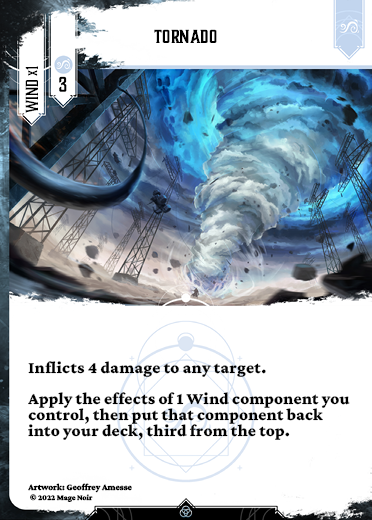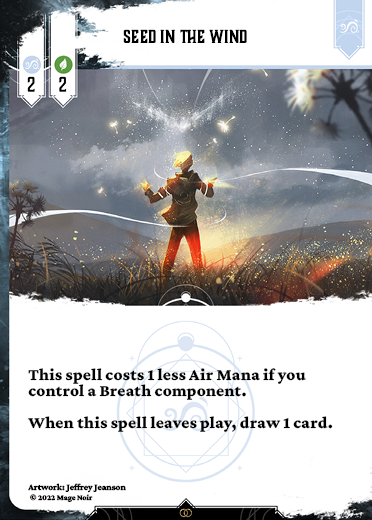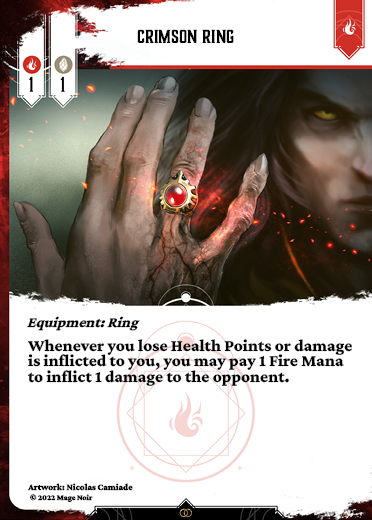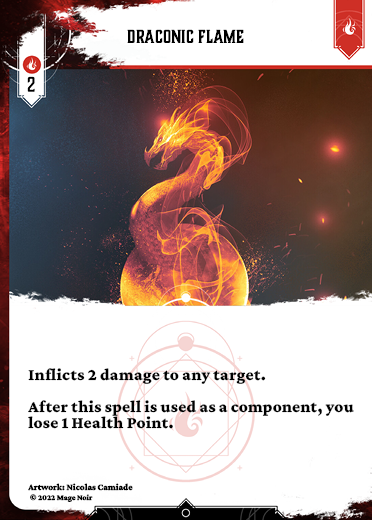“At any time” effects, chains of events and indivisible actions
Hi there Mages!
We decided to write this explanation to clarify the order in which effects resolve during edge cases, as well as the different moments when effects may occur.
Please note: This is advanced rule clarification. It is not necessary to understand this when playing most of your Mage Noir games, especially for games played between friends. This is why these rules are outside of the rulebook. However, they are just as official as those in the rulebook. These clarifications are mostly useful for competitive players as well as judges.

To start with, here are some terms
To make sure we’re on the same page, we’ll start by defining a few terms that we’ll use in the following explanation. We’ll also give some detailed examples to illustrate them.
Indivisible action
An “indivisible action” is, by definition, an action that cannot be divided, or interrupted by any means.
Here are some examples of indivisible actions:
- Adding Mana to the Available Ether (whether it is during the Mana gathering phase, by paying Mana, or releasing Mana)
- Any effect of a spell that is written on a single paragraph (unless it contains the word “then”, because if it contains “then”, that means it is 2 indivisible actions.)
- Channeling a spell
- Preparing a spell
- Trading 2 Mana for 1 Mana in the Available Ether
- Taking one of the 2 Mana piles
- Discarding a card
- Drawing a card
A concrete example
An example we like to use at Double Combo Games is casting Tornado with Seed in the wind as a component, as it is a good spell to check the chain of effects.
Here is the state of the game:
- You have a Tornado in preparation.
- You have a Seed in the wind channeled on the board


In the following example, each line preceded by a bullet point is considered as an indivisible action.
You decide to activate Tornado (this adds the following indivisible actions as a chain of events. For each action that needs a target, you select the target right now)
- You deal 4 damage to any target (your opponent).
- You apply the effects of one of your channeled Wind components (Seed in the wind)
- Seed in the wind only has triggered effects, so nothing happens.
- You put the selected wind back into your deck (so still Seed in the wind). This is a separate indivisible action since the effect has a “then” in its text.
- You draw a card (since Seed in the wind has left play, so its triggered effect happens).
- The Mana from Seed in the wind is released since it left play.
- Tornado has finished its effects and is now discarded.
- The Mana from Tornado is released since it left play.
Chains of events
A chain of events consists of one or multiple indivisible actions that occur one after the other and that need to be resolved till the end before a new chain of events may start. The resolution of the chain of events may add one or more new indivisible actions in the chain, making it longer as it goes.
A concrete example:
A good example for a chain of events is the back and forth between 2 Crimson rings.
Here is the state of the game:
- You and your opponent both have a huge amount of HP and Mana (enough to make sure this is not an issue in the example).
- You both have one Crimson ring equipped.
- You have a Draconic flame in preparation.


You decide to activate your Draconic flame starting a chain of events.
- You inflict 2 damage to the opponent.
- The opponent loses 2 HP. Their Crimson ring triggers and adds a new indivisible action to the chain of events.
- The opponent decides to pay 1 Fire Mana to inflict 1 damage to you.
- You take 1 damage. Your Crimson ring triggers and adds a new indivisible action to the chain of events.
- You decide to pay 1 Fire Mana to inflict 1 damage to the opponent.
- This chain of events can get longer and longer as long as you and your opponent decide to keep going like this.
- At some point you decide to not pay the Fire Mana. Your opponent doesn’t take damage and we get to the rest of the chain of events.
- Draconic flame finished its effects and is now discarded.
- The Mana from Draconic flame is released.
All of these back and forth are considered as a single chain of events. While you and your opponent make the chain longer and decide what to do with your Crimson rings, none of you are allowed to cast spells, or perform any other action that would create a new chain of events.
One last thing about chains of events:
When multiple actions happen at the same time, the player whose turn it is chooses in which order they resolve.
The resolution of these effects one after the other is considered as a single chain of events.
When can I perform actions?
Well, it depends on the type of action that is happening. We differentiate between 3 types of actions.
Regular actions
These are the actions you can only perform during your main phase. They are actions that start a chain of events like activating a spell or using an activated ability from a ritual. This is the regular way spells are played in general.
Do note that when you’re performing a regular action, for each indivisible action that requires a target, you have to state the target when you announce the action.
An example
For instance, as explained in the rulebook (page 10), activating any spell during your main phase is starting the following chain of events.
- Applying the spell’s effect, adding all of its indivisible actions in the chain of events and requiring you to choose every target for each one by one (if needed).
- Discarding the spell
- (as a result of discarding the spell) Releasing its Mana
Triggered actions
Some spells may have actions that only happen when they are triggered by a certain event.
When they are triggered, these effects are instantly added to the current chain of events that triggered them as the next indivisible action.
You have no choice on the time of activation of those, so they are usually simple to apply.
An example
The example of the “Crimson ring” above is still a very valid explanation to illustrate how triggered actions work.
“At any time” effects
These are the least common ones and will be much more present with the arrival of the Quickcast keyword. Actions that you may use “at any time” can be used right before or right after any chain of event, but not during their resolution. This will place the chain of events from the “at any time” effect right before (or right after) the one that is about to resolve.
In consequence, here is a list of all the times you may activate an ability that is “at any time”:
- Right at the beginning or at the end of any player’s turn phase (which are):
- Turn start
- Draw phase
- Mana gathering phase
- Main phase
- Turn end
- Right before or right after the activation of a player’s spell. (Do note players need to announce targets BEFORE the spell resolves if they need to designate targets)
- Right before or right after a player decides to use an ability of one of their spells (such as activated ritual abilities)
- Right before or right after the preparation or channeling of a spell.
- Right before or right after a player decides to trade Mana.
- Right before or right after any player adds Mana to the available Ether during the Mana gathering phase.
- Right before or right after any player takes one of the two piles of Mana during the Mana gathering phase
- Right before or right after a player has to discard a card at the end of their turn because of a too-large hand
An example:
The following chain of events could happen:
You have a Fire whip and a Warrior-Mage ritual.
Your opponent has a Divine hammer strike prepared and it’s their turn.



Your opponent activates Divine hammer strike during their main phase, targeting your Fire whip. This starts the following chain of events.
- Divine hammer strike destroys your Fire whip.
- The Mana from Fire whip is released.
- Divine hammer strike has finished its effects and is now discarded.
- The Mana from Divine hammer strike is released.
Right before the chain of events starts, you decide to use the ability of your Warrior-Mage ritual. The chain of events now becomes the following:
- (New) You activate the ability of Warrior-Mage ritual
- (New) You discard a card from hand
- (New) Your Fire whip is now indestructible
- (Changed) Divine Hammer strike tries to destroy your Fire whip which is indestructible. The target is invalid so nothing happens.
- Divine hammer strike finished its effects and is now discarded
- The Mana from Divine hammer strike is released.
Do note that players may both want to apply their “At any time” effect before the other player does. In this case we consider that both players are trying to use their spell at the exact same time and thus the order resolution is up to the player whose turn it is.
That’s it for today mages!
We hope this was helpful, until next time though, have a nice day Mages and have fun!
~ The Mage Noir Team.